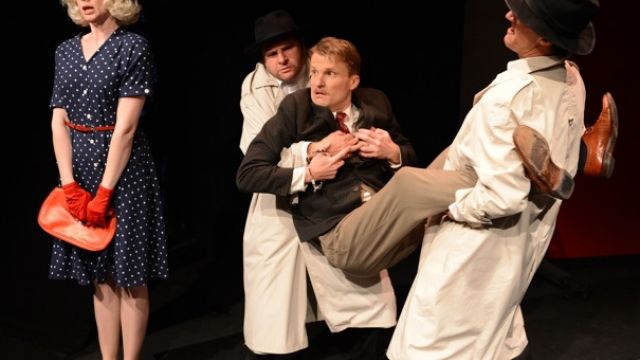The 39 Steps
Since its resounding success in London and New York, this play has become the new ‘pop’ comedy for community theatre. It has much appeal. To begin with, for the audience, the story is well known through book, the film and television make-overs – and the dashing but beleaguered Richard Hannay was, after all, the very first of the British super spies. But for theatre practitioners, the play has even more altruistic appeal. It is, at once, a director’s play, an actor’s play, a designer’s play – and a stage management nightmare! Its comedy relies on creative collaboration, tight control and a commitment to strive for perfection in pace and timing across the production.
If it’s good, the play can be very funny – and this production at the Pavilion Theatre is as close to professional as community theatre comes. It is finely honed. Clever direction and committed, experienced performers and designers are supported by skilled operators and slick stage management, resulting in a fast, tightly-paced production that has the audience smiling, laughing, gasping and congratulating.
Director Meredith Jacobs has a flair for seeing the creative possibilities in comic moments and in this play there are many. What makes them work in Jacobs’ production is the careful coordination of her vision. Her realisation that the play’s success relies upon the interdependency of the action and effects through thirty three scenes, multiple character changes, much fast action, many sight gags, a myriad of sound and lighting cues – and very tight rehearsal.
There are many moments that are beautifully executed and coordinated. There is the train chase, where lighted windows flash across the darkened scrim while the actors mime the chase inside, outside and above the carriage with some very clever effects. A bridge and a ‘puppet’ plane are silhouetted behind the scrim, both accompanied by very funny and predictable sound effects. An over-large map, revolving doors, repeated movements, held freezes, funny beards and other gags are audience pleasers as long as they work – and in most cases, because of the tightness of the production, they do.
As Richard Hannay, Paul Sztelma is totally in command of the character, obviously loving this gift of a role that makes the most of his comic timing and physical skills. Leigh Scanlon is funny and quirky and convincing as the three very different female characters. She is also obviously relishing the opportunity to use her considerable stage experience in a comic role.
As the Clowns – and the many characters they become – Dave Went and Richard Ifield bounce off each with well rehearsed efficiency. Their energy and timing are important to the continuity of the production and both work very hard to sustain the pace of the action – as do the sound and lighting operators and the busy stage crew.
This production is one where working together really does seem to have been the key to success. It is evident in the tight control of the whole performance and the fact that the cast is enjoying every frantic moment.
Carol Wimmer
Photographer: Chris Lundie
Subscribe to our E-Newsletter, buy our latest print edition or find a Performing Arts book at Book Nook.

